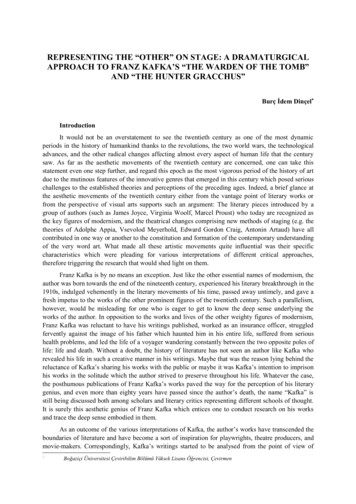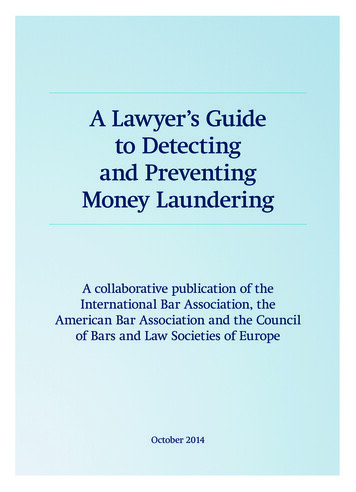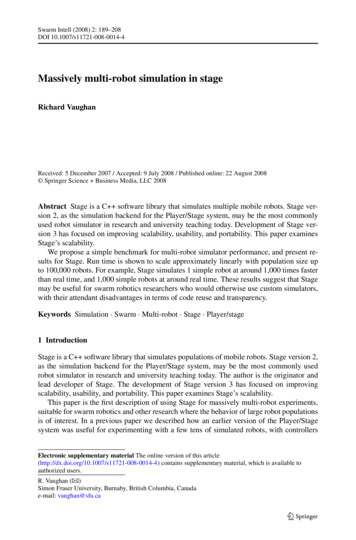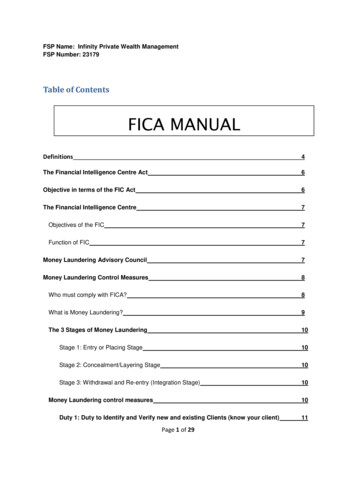
Transcription
REPRESENTING THE “OTHER” ON STAGE: A DRAMATURGICALAPPROACH TO FRANZ KAFKA’S “THE WARDEN OF THE TOMB”AND “THE HUNTER GRACCHUS”Burç İdem Dinçel IntroductionIt would not be an overstatement to see the twentieth century as one of the most dynamicperiods in the history of humankind thanks to the revolutions, the two world wars, the technologicaladvances, and the other radical changes affecting almost every aspect of human life that the centurysaw. As far as the aesthetic movements of the twentieth century are concerned, one can take thisstatement even one step further, and regard this epoch as the most vigorous period of the history of artdue to the mutinous features of the innovative genres that emerged in this century which posed seriouschallenges to the established theories and perceptions of the preceding ages. Indeed, a brief glance atthe aesthetic movements of the twentieth century either from the vantage point of literary works orfrom the perspective of visual arts supports such an argument: The literary pieces introduced by agroup of authors (such as James Joyce, Virginia Woolf, Marcel Proust) who today are recognized asthe key figures of modernism, and the theatrical changes comprising new methods of staging (e.g. thetheories of Adolphe Appia, Vsevolod Meyerhold, Edward Gordon Craig, Antonin Artaud) have allcontributed in one way or another to the constitution and formation of the contemporary understandingof the very word art. What made all these artistic movements quite influential was their specificcharacteristics which were pleading for various interpretations of different critical approaches,therefore triggering the research that would shed light on them.Franz Kafka is by no means an exception. Just like the other essential names of modernism, theauthor was born towards the end of the nineteenth century, experienced his literary breakthrough in the1910s, indulged vehemently in the literary movements of his time, passed away untimely, and gave afresh impetus to the works of the other prominent figures of the twentieth century. Such a parallelism,however, would be misleading for one who is eager to get to know the deep sense underlying theworks of the author. In opposition to the works and lives of the other weighty figures of modernism,Franz Kafka was reluctant to have his writings published, worked as an insurance officer, struggledfervently against the image of his father which haunted him in his entire life, suffered from serioushealth problems, and led the life of a voyager wandering constantly between the two opposite poles oflife: life and death. Without a doubt, the history of literature has not seen an author like Kafka whorevealed his life in such a creative manner in his writings. Maybe that was the reason lying behind thereluctance of Kafka’s sharing his works with the public or maybe it was Kafka’s intention to imprisonhis works in the solitude which the author strived to preserve throughout his life. Whatever the case,the posthumous publications of Franz Kafka’s works paved the way for the perception of his literarygenius, and even more than eighty years have passed since the author’s death, the name “Kafka” isstill being discussed both among scholars and literary critics representing different schools of thought.It is surely this aesthetic genius of Franz Kafka which entices one to conduct research on his worksand trace the deep sense embodied in them.As an outcome of the various interpretations of Kafka, the author’s works have transcended theboundaries of literature and have become a sort of inspiration for playwrights, theatre producers, andmovie-makers. Correspondingly, Kafka’s writings started to be analysed from the point of view of Boğaziçi Üniversitesi Çeviribilim Bölümü Yüksek Lisans Öğrencisi, Çevirmen
theatre studies, visual arts, and film studies. Yet, most of the research done within the realm of thesedisciplines have focused either on the dramatic notions of Kafka’s novels, short stories, and aphorismsor on the adaptations done from the author's writings.1 Indeed, the twentieth century is rife withexamples of adaptations of Kafka’s creations which set the groundwork for such analyses: in terms oftheatre productions, André Gide and Jean-Louis Barrault's adaptation of Kafka’s The Trial (1947),Mark Rozovsky’s Father and Son (1992), Alan Bennet’s Kafka’s Dick (1986), and The InsuranceMan (1986) and regarding the silver screen, Orson Welles’s The Trial (1962), Danièle Huillet andJean-Marie Straub’s The Man Who Disappeared (1983), and Steven Soderbergh’s Kafka (1991) can beshown as representative examples of this fact.2Under close observation, one can see how all these adaptations have taken either merely thebiographical factors concerning Kafka’s life or the dramatic motifs of his novels as a point ofdeparture for their productions. When a theatre performance and a cinema production are compared, itcan be deduced that, while in the latter the production flourishes mostly through the creative mind ofthe director, in the former, the director feels him or herself to a certain extent bound to the dramatist;after all, a theatre play is the creation of a playwright in the first place. Hence, in the case of thestudies concerned with Kafka’s theatre adaptations, a fundamental problem arises; that is to say,instead of assessing Kafka’s aesthetic values as a dramatist, the author has mostly been evaluated bytheatre scholars either as a prose work writer or a literary figure stimulating a work of art intending tointerpret an already existing creation from a different perspective.Even though Franz Kafka is chiefly regarded as one of the most powerful novelists and shortstory writers of the twentieth century, the author’s one-act drama “The Warden of the Tomb” (DerGruftwächter), written circa 1916-1917, clearly testifies to Kafka’s intention of trying his hand atwriting a theatre text,3 thus setting the basis for an evaluation of the author as a playwright. Lookingfrom this standpoint, one can observe how theatre studies –to a certain degree– have neglectedanalysing Kafka as a dramatist by failing to take the author’s only theatrical writing as a focal point. 4Moreover, an additional fragment of one of the short stories of the author, namely “The HunterGracchus” (Der Jäger Gracchus), composed in 1917, calls for a (re)reading of this text along with“The Warden of the Tomb” due to the shared features of the two works. In addition to that, “TheWarden of the Tomb”’s open-ended feature allows a researcher to read it in connection with “TheHunter Gracchus” with the purpose of moving these two texts from page to stage.1234See for instance, Una Chaundri, Staging Place: The Geography of Modern Drama, Michigan: MichiganUniversity Press, 1997, pp. 196-197; Zehra İpşiroğlu, Eleştirinin Eleştirisi, Istanbul: Mitos Boyut, 1998, pp. 90-96;Osman Durrani, “Editions, Translations, Adaptations”, in Julian Preece (ed.) The Cambridge Companion to Kafka,Cambridge: Cambridge University Press, 2002, pp. 219-222; John Zilcosky, Kafka’s Travels, 2003, Basingstroke:Palgrave Macmillan, pp. 97-98 and pp. 111-114.For a study regarding the Kafka adaptations in the movie industry, see Martin Brady and Helen Hughes, “KafkaAdapted to Film”, in Julian Preece (ed.) The Cambridge Companion to Kafka, Cambridge: Cambridge UniversityPress, 2002, pp. 226-241In fact, a close reading of Kafka’s Diaries fortifies this argument to a certain extent. As early as 1911, Kafka, whiledepicting his dreams taking place in a theatre, writes sketches of a drama piece. Having a dream taking place on a theatrestage indicates the author’s interest in theatre. Other dramatic fragments written down by Kafka in his diary in 1913 andin 1917 respectively, strengthens this argument even more, see Franz Kafka, Max Brod (ed.) The Diaries of FranzKafka, trans. Joseph Kresh and Martin H. Greenberg, 1999, London: Vintage, pp. 111-113, 119-124; esp. pp. 123-124,229-230, 377-379.The same situation holds true for the productions of “The Warden of the Tomb” as well. The sparse amount ofproductions of the play can be taken as a token of the negligence of the academic world regarding Kafka’s one-act dramaresulted in the lack of staging the play. “The Warden of the Tomb” was staged rather recently as a “modernized” comedyadaptation by a theatre group from Taiwan, namely New Bodo Troupe in August /2003/08/22/2003064816, 03.05.2009), and was put on by an Italiandirector Armando Adolgiso at the early phases of his career as an “avant-garde text”(http://www.adolgiso.it/autoscatto eng.asp, 03.05.2009), and was performed by Théâtre de la Bastille in 1983, see JohnStrand, “Théâtre de la Bastille” in The Drama Review 28 (1), p. 95.
With these assumptions in hand, this study will attempt to evaluate Kafka as a playwright, andoffer a dramaturgical approach to the two texts of this author in question, with the intention ofproviding a new insight to the readers of Kafka from the perspective of theatre studies. In order tomove “The Warden of the Tomb” and “The Hunter Gracchus” from page to stage, the paper willpresent the necessary theoretical framework/s regarding a staging process as well as a dramaturgicalapproach prior to the application part of the study. Additionally, as far as the case of “The Warden ofthe Tomb” is concerned, another intention of the paper will be to shed light on a Kafka text that hasbeen left almost untouched by scholars up to now.A Dramaturgical Approach to Franz Kafka’s “The Warden of the Tomb”The ultimate function of dramaturgy during the staging process, according to Edward M.Cohen, “is to supply writers and directors with a pair of audience eyes so that the audience viewpointwill not come as a surprise on opening night.” 5 In this respect, one can regard a dramaturge as one ofthe most crucial figures of a staging process, who translates the script from the literary language intothe stage language, and eventually becomes the critical eye of a theatre company, which evaluates thefinal creation from the viewpoint of the spectator. In order to find the appropriate transformationstrategy, a dramaturge analyses the text/s in question both from the perspective of a literary work andfrom the vantage point of a potential visual artwork. An exhaustive textual analysis is the core of adramaturgical approach owing to the fact that only after a thorough analysis can one comprehend theessential meaning of a text to be staged. The most crucial part of a textual analysis is the interpretationof the stage directions due to the fact that it is these parts of a script in which a playwright revealsfundamental features of the play’s characters most obviously. Furthermore, since stage directions“define the concrete conditions of the discourse of the play” 6 together with the hints they include inorder to find the suitable acting style, a misinterpretation of them might distort the crux of the text, andas a consequence the performance to a certain extent.In opposition to the proponents of the view that reduces the role of a dramaturge in the stagingprocess,7 it is also possible for a dramaturge and a director to establish a dialectical relationship. Sincea given staging process evolves gradually as a result of a dialectical relationship among the actors,stage designer, director, and the other figures involved in the making of a production, a confinedapproach intending to constrain the role of dramaturgy in the course of staging would be equal toputting an end to the dynamic function inherent in dramaturgy. When the work is almost finished,states Eugenio Barba, “he [a dramaturge] stops and says that now it can really begin. Those aroundhim [sic] express stupor and incomprehension. Meanwhile he disarranges and destroys everything hehas done up to that moment. He draws other scenes and figures, which he interweaves orsuperimposes on the preceding ones, cancelling them out.” 8This overall outlook concerning the function of a dramaturgy during the course of a stagingprocess provides the framework necessary for an analysis of Franz Kafka’s one-act drama “TheWarden of the Tomb”. As stated previously, Kafka’s one-act drama “The Warden of the Tomb” is themost evident example of the author’s interest in writing a theatre text. Kafka’s description of the56 78Edward M. Cohen, Working on a New Play, New York: Limelight Editions, p. 34Esen Çamurdan, Çağdaş Tiyatro ve Dramaturgi, Istanbul: Mitos Boyut, 1996, p. 92Unless indicated all translations are my own.Cf. Edward M. Cohen, Working on a New Play, New York: Limelight Editions, p. 32, p. 34Eugenio Barba, “The Deep Order Called Turbulence: The Three Faces of Dramaturgy”, in Henry Bial (ed.) ThePerformance Studies Reader, London and New York: Routledge, 2004, p. 257. For a brief account on the importance ofthe dialectical relationship between a dramaturge and the other members of a given theatre company, see Esen Çamurdan,Çağdaş Tiyatro ve Dramaturgi, Istanbul: Mitos Boyut, 1996, pp. 98-102, and for the dynamic function of dramaturgyin terms of providing staging interpretations, see Zehra İpşiroğlu, Tiyatroda Düşünsellik, Istanbul: Mitos Boyut, 1995,pp. 18-23
“undead”, the ambiguous structure of the play, the stage directions suggesting a rather different way ofacting and the author’s construction of the plotline are the most obvious factors which invite anassessment of this writer as a dramatist. However, as the analysis of the play will plausibly point out inthe following pages, Kafka’s construction of the plotline to a certain extent comprises the componentsof a prose work which aids him during the course of complicating the events of the text.The peculiar opening of “The Warden of the Tomb” leaves the impression on the reader that theplay starts during the course of some action; in other words, something “should have taken place”right before the start, thus serving as an element of a literary piece which lures the attention of thereader:PRINCE (turning from window): Well?CHAMBERLAIN: I cannot recommend it, your Highness.PRINCE: Why?CHAMBERLAIN: I can’t quite formulate my objections at the moment. I’m expressing only afraction of what’s on my mind when I quote the universal saying: Let the dead rest in peace. 9Right from the start then, the image of the “undead” occupies an overwhelming presencethroughout the play. Similarly, as the play proceeds, Kafka shifts the focus of attention from thequestion “what happened before” to “who is the human and who is the other”, therefore signifying thecrucial function of the image of the non-living in the text. By blurring the distinctions between theplay characters, Kafka leaves the reader with questions in mind at the end of the play. The reader, whosaw the Warden as the main character of the play and even felt compassion for him to some degreeduring the course of the piece, cannot be sure if the Warden is human or not when s/he witnesses thesewords towards the end of the play:STEWARD (stamping his foot): Is it impossible to get rid of him? Pick him up in your arms ifthere’s no other way. Can’t you understand what’s expected of you!CHAMBERLAIN: The Prince!SERVANT (opening door at left)STEWARD: Ah! (Glances at Warden.) I should have known that ghosts cannot be transported.10Even though the overall structure of the play is obscure enough to comprehend a pivotal featureof Kafka’s texts, which “generates a second, an excessive text flying off from the first,” 11 surfaces in“The Warden of the Tomb” as well and assists the reader to grasp the plotline of the work. A closereading of the entire text reveals that the text itself can be divided into two main parts: the first phaseof the play informs the reader of the Prince’s plan which aims at stationing a warden on the frontierbetween the human and the non-human, 12 whereas the second phase of the work gives the plausiblereasons for the Prince’s intention. During the course of the play, the reader comprehends that theSteward has come to the palace from a foreign court with the Princess six months ago, struggling toestablish an order as opposed to the already existing one,13 and accuses the Chamberlain of flirting910111213Franz Kafka, “The Warden of the Tomb” trans. Tania and James Stern, in Nahum N. Glatzer (ed.) The CompleteShort Stories of Franz Kafka, London: Vintage, 1999, p. 206Ibid., p. 218Stanley Corngold, “The Life of the Author in the Margin of His Breaks: On Kafka’s Perspective”, in Moshe Lazarand Ronald Gottesman (eds.) The Dove and the Mole: Kafka’s Journey into Darkness and Creativity, Malibu:Undena Publications, 1987, p. 185Franz Kafka, “The Warden of the Tomb” trans. Tania and James Stern, in Nahum N. Glatzer (ed.) The CompleteShort Stories of Franz Kafka, London: Vintage, 1999, p. 207Ibid., p. 216
with the opposition.14 In this regard, one can fathom the Prince’s friendly behaviour towards theWarden: Prince Leo, without having seen the Warden before, considers him as a messenger whotransmits the words of the “Other” to the human and trusts his words instinctively. In this light, onemay even take a step further and claim that Prince Leo regards the Warden as a courier bearing themessages of his ancestors, whom he may also consult in his struggle for preserving the establishedorder of the principality. The Chamberlain, who seems to be one of Prince Leo’s right-hand men,declares clearly how he “still represent[s] the open policy that prevailed under Duke Friedrich. Atthat time the only policy at Court was to serve the Prince.” 15 In this sense, one can infer how PrinceLeo is in favour of the established order of his ancestors. The Steward’s seeing the Warden as “anupright, active worker for evil”16 reinforces the idea of the Steward’s hostility towards the order ofPrince Leo. Furthermore, when the second phase of the play is examined in the light of GeorgeSteiner’s comment which reads as “behind the nightmare exactitudes of Kafka’s setting lies thetopography of Prague and of the Austro-Hungarian empire [sic] in its decline,” 17 the ambiguity of thetime and the setting in which the play takes place fades away. 18 In this regard, “The Warden of theTomb” can take place in a year towards the end of the First World War, that is to say, in 1917, whichwould signify the dissolution years of the Austro-Hungarian Empire. Moreover, the most probablesetting for the play can be Prague, the capital-to-be of Czechoslovakia, the country that wouldeventually gain its independence in 1918. When observed from this viewpoint, it can be surmised howone of the most key components of classical tragedy, that is to say, a palace intrigue, has become oneof the most significant factors of a dramatic piece in the hands of Kafka.19As mentioned in the beginning of this paper, the history of literature has not seen another writerlike Kafka who expanded on the sufferings, affairs, disappointments of his life throughout hiswritings. When the author’s depictions of the “undead”, therefore the “ghosts” are taken intoconsideration in the light of the repercussions of the very word “death” in the other writings of theauthor, particularly after 1917 (the year when the writer suffered a haemorrhage for the first time), theimage of the undead depicted in “The Warden of the Tomb” takes the shape of a terrifying phenomenasuffocating the thoughts of Kafka. A look at the description of the undead throughout the playindicates that the image of death –just like the tuberculosis that would eventually put an end toKafka’s life in 1924– dominates the plotline, and finally “it becomes clear that the boundary betweenthe principality and the region of the dead is shifting, as the dead-space encroaches.” 20 From thestandpoint of this autobiographical resonation of the death image in “The Warden of the Tomb”, it canbe inferred that Kafka used this metaphor as a symbolic narrative tool which complicates the events ofthe plotline.An additional –and maybe more significant in terms of Kafka’s usage of a symbolic narrativetool– component of “The Warden of the Tomb” is the author’s employment of the image of “TheTower of Babel”. As stated by George Steiner, “Kafka saw in the Tower and its ruin a dramaticshorthand through which to convey certain exact, though not wholly articulate, intimations about14151617181920Ibid., p. 215Ibid.Ibid., p. 218George Steiner, Language & Silence, Yale: Yale University Press, 1998, pp. 120Even though Steiner’s comment is surely not concerned with “The Warden of the Tomb”, the scholar’s terseremark serves as a starting point for one during the course of puzzling over the time and the setting of the play.Kafka’s usage of a palace intrigue in this play becomes quite significant when one thinks of the general tendency ofthe playwrights of his time. Indeed, dating from the eighteenth century onwards the function of palace affairs wasgradually swept away from the theatre stage due to Denis Diderot’s introduction of the concept of Bourgeois Drama. Cf.Burç İdem Dinçel, “Burjuva Dramı, Denis Diderot ve Tiyatroda Gerçekçilik”, in Tiyatro Eleştirmenliği ve DramaturjiBölümü Dergisi 8, Istanbul: Istanbul University Press, pp. 50-56. In this respect, Kafka’s usage of a palace intrigue in“The Warden of the Tomb” can be regarded as a representative example of the author’s (re)interpretation of a traditionaltheatrical component in the twentieth century.Daniel Albright, Beckett and Aesthetics, Cambridge: Cambridge University Press, 2003, p. 30
man’s linguistic condition.” 21 According to Steward, Prince Leo “needs all his energy for the secondhalf [of himself] which scrapes together the foundation needed to build something like the Tower ofBabel” 22 with the purpose of achieving the ultimate silence that would offer him the uniqueopportunity to comprehend the message of his ancestors, which is eventually a must for him tostrengthen the basis of his already established order. By using the myth of Babel –the myth in whichmankind is sentenced to eternal silence– in a theatre text then, Kafka digs the foundations of thesphere of theatre in which language, speech, dialect and words prevail. From the vantage point of thegenres evolved within the realm twentieth century drama, in this respect, one can regard Kafka as oneof the forerunners of the theatre of the absurd in which the meaning inherent in words along with theperception of the world disappears.23A Dramaturgical Approach to Franz Kafka’s “The Hunter Gracchus”When Kafka’s usage of the image of the “dead” both in “The Warden of the Tomb” and in thetwo versions of “The Hunter Gracchus” are compared, one can see how the author’s depiction of theundead goes in close association in the latter piece more than it does in the former one with thewriter’s anxieties concerning “death” in his life. As stated previously, both of the pieces were writtenmore or less in the same period of Kafka’s life, namely around 1916-1917 when the author had hisfirst tubercular outburst. By the same token, “The Hunter Gracchus”, in the words of AnthonyNorthey, is one of the few examples of “Kafka’s fiction when he actually names and describes a reallocale.” 24 However, in addition to Kafka’s worries of dying, the main idea of “The Hunter Gracchus”emerges chiefly from a real event of which the author was aware, that is to say, a suicide of one of theretired major generals of the Austrian army whom the writer knew close enough to mention his name–Ludwig von Koch– in a letter to his friend Max Brod in 1913. 25 Anthony Northey summarizessuccinctly that “the story’s motif is derived from the myths surrounding suicide: the soul that cannotfind eternal rest.” 26 Furthermore, when Northey’s observation is taken into consideration inconjunction with Kafka’s entry in his diary on the sixth of April in 1917,27 the author’s usage of realevents during the course of writing “The Hunter Gracchus” bestows upon this short story a trait of arealistic piece of writing.Nonetheless, Kafka’s forging these realistic events with his own comprehension of death in apeculiar way constitutes the main point of “The Hunter Gracchus”. When taken into account that thewriter’s surname Kafka and the name of the legendary hunter, which is at the same time the name of a21George Steiner, After Babel: Aspects of Language and Translation, Oxford: Oxford University Press, 1977, p.66222324252627Franz Kafka, “The Warden of the Tomb” trans. Tania and James Stern, in Nahum N. Glatzer (ed.) The CompleteShort Stories of Franz Kafka, London: Vintage, 1999, p. 206For an account of Kafka’s influence on the theatre of the absurd, see Zehra İpşiroğlu, Tiyatroda Düşünsellik,Istanbul: Mitos Boyut, 1996, pp. 15-40. İpşiroğlu’s study provides a fruitful analysis of the theatre of the absurd ingeneral, yet the scholar does not refer to Kafka’s one-act drama in her study, and further mentions that Kafka has notwritten a theatre text, see p. 76.Anthony Northey, “Myths and Realities in Kafka Biography”, in Julian Preece (ed.) The Cambridge Companionto Kafka, Cambridge: Cambridge University Press, 2002, p. 196Ibid.Ibid.6 April. Today, in the tiny harbour where save for fishing boats only two ocean-going passenger steamers used tocall, a strange boat lay at anchor. A clumsy old craft, rather low and very broad, filthy, as if bilge water had been pouredover it, it still seemed to be dripping down the yellowish sides; the masts disproportionately tall, the upper third of themainmast split; wrinkled, coarse, yellowish-brown sails stretched every which way between the yards, patched, too weakto stand against the slightest gust of wind.I gazed in astonishment at it for a time, waited for someone to show himself on deck; no one appeared. A workman satdown beside me on the harbour wall. “Whose ship is that?” I asked; “this is the first time I’ve seen it.”“It puts in every two or three years,” the man said, “and belongs to the Hunter Gracchus” Franz Kafka, Max Brod (ed.)The Diaries of Franz Kafka, trans. Joseph Kresh and Martin H. Greenberg, 1999, London: Vintage, p. 373
famous Roman family, both allude to a jackdaw, 28 it becomes evident that the Hunter Gracchus isactually the author, who felt himself closer to death than ever before in his life. Kafka, contrary to thegeneral fear of a human being towards death, regards dying as a journey embarked on with the purposeof finding the eternal rest. What Kafka fears, on the other hand, is the failure to find a place to rest andto wander aimlessly in the world just like Gracchus does. “I had been glad to live and I was glad todie,”29 says Gracchus, indicating how he is ready to enter the other world by all means. Yet, he cannotdie; he cannot even enter the margins of the other realm. Instead, Gracchus finds himself trapped onthe great stair which leads up to the underworld. As John Zilcosky states in his exhaustive study:“Kafka imagines that–by preventing the endless, posthumous circulation of his texts– he mightfinally gain a resting place. Writing’s annihilation might allow him to cease being what he had chosento become a writer, prowling the exotic space between life and death. If no one reads his writing,Kafka imagines he might escape Gracchus’ limbo–and the ghosts that inhabit it–and reach death’sPromised Land” 30In this regard, the purpose of Kafka’s last testament in which he puts momentous emphasis onthe destruction of his entire works, and implores Max Brod to burn all of his writings can be taken as adesire of the author delineated in the character of Gracchus.In the light of this close reading of “The Warden of the Tomb” together with Kafka’s usage ofthe image of “death” in “The Hunter Gracchus”, an additional fragment of the short story, which waswritten in a dialogue form as opposed to the finished version of it, acquires the legitimate ground for adramaturgical analysis. In a manner evoking “The Warden of the Tomb”, this piece is full of dramaticelements focusing mainly on the image of the undead. In “The Hunter Gracchus”, the reader isinformed of the voyage of a legendary hunter, his “otherness” in a world that is located somewherebetween life and death, and the hunter’s conversation –presumably– with the Burgomaster of Riva.31Gracchus, in the strict sense of the word, represents the “Other” in this piece. The Hunter is neitheralive nor dead, moreover, is surprised at the living people’s unawareness of his past and legends, andin this sense, resembles a character living in an ivory tower unaware of the vicissitudes of the world.Contrary to the stable figure of an ivory tower, on the other hand, Gracchus is a moveable characterwho wanders endlessly in a vague world and considers his own self as a legendary one. What is more,Gracchus surprises and gets even irritated when he witnesses the living people’s lack of knowledgeregarding his past:These are your observations my dear friend, other people have made others. There are only twopossibilities here. Either you conceal what you know about me, and do so with a definite motive. Inwhich case let me tell you frankly: you are on the wrong track. Or you actually think that you can’tremember me, because you confuse my story with someone else’s. In that case I can only tell you: Iam–no, I can’t, everyone knows it and [sic] of all people I should be the one to tell you! It’s so longago. Ask the historians! Go to them, and then come back. It’s so long ago. How can I be expected tokeep it in this overcrowded brain? 32Gracchus, however, persists that every single human being in the world is aware of his legend:[ ] All the books are full of it, teachers draw it on the blackboard in every school, the motherdreams of it while sucking her child, lovers murmur it while embracing, merchants tell it to the2829303132Cf. Ritchie Robertson, Kafka: A Very Short Introduction, Oxford: Oxford University Press, 2004, p. 40Franz Kafka, “The Hunter Gracchus” trans. Willa and Edw
2 For a study regarding the Kafka adaptations in the movie industry, see Martin Brady and Helen Hughes, "Kafka Adapted to Film", in Julian Preece (ed.) The Cambridge Companion to Kafka, Cambridge: Cambridge University Press, 2002, pp. 226-241 3 In fact, a close reading of Kafka's Diaries fortifies this argument to a certain extent. As .











